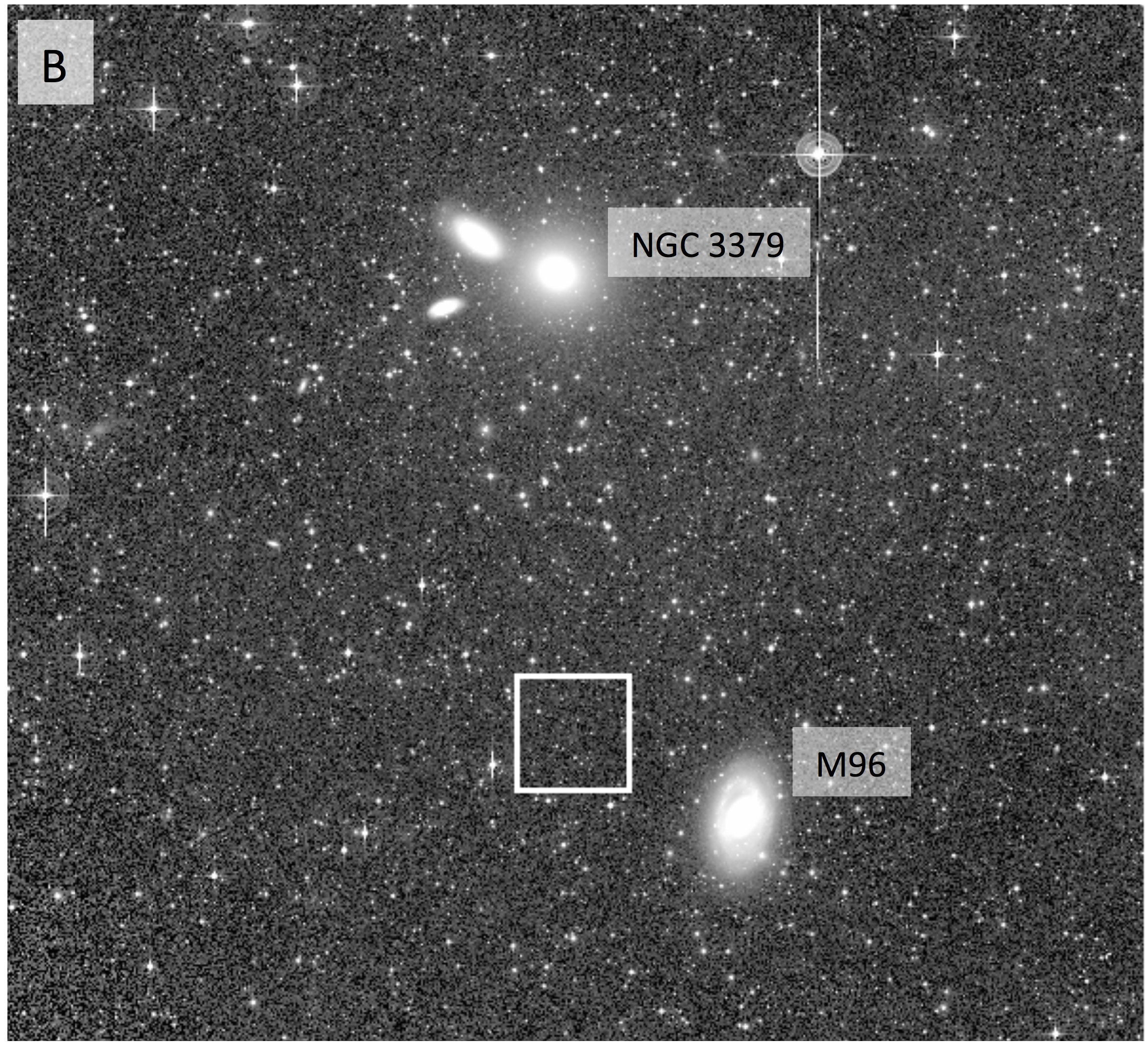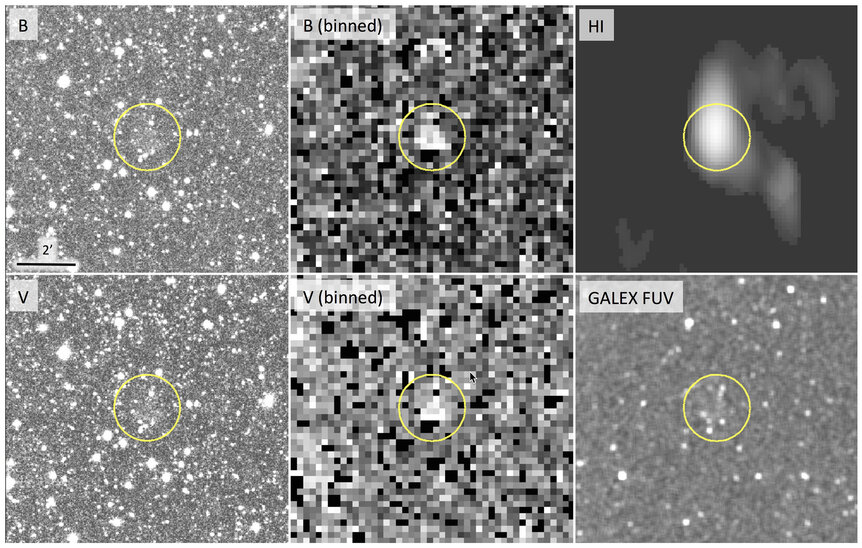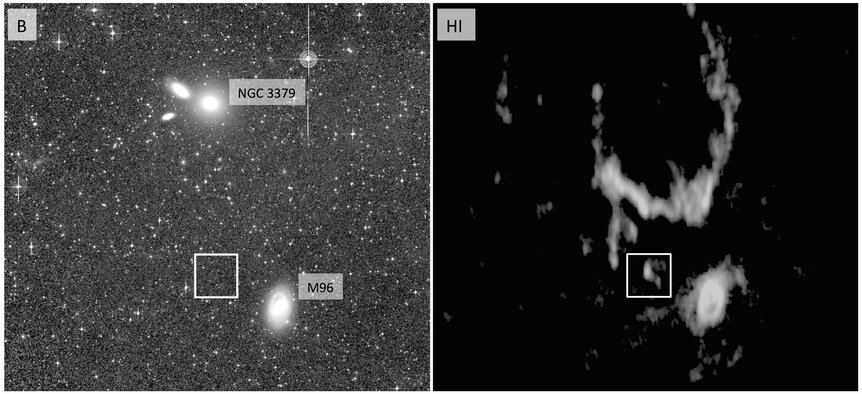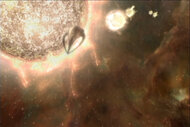Create a free profile to get unlimited access to exclusive videos, sweepstakes, and more!
Is this faint smear of a light a galaxy or the guts ripped out of a galaxy?

You’d think that by now we’d have mapped out everything in near-galactic space. We’ve been scanning the skies for centuries, and using pretty sophisticated tech the past few decades. Digital detectors are getting ridiculously sensitive and so big that wide fields of view can be observed rapidly. Automated software is routinely used to detect comets and asteroids in the solar system, as well as stars and even galaxies beyond.
But mysteries still abound. After all, sure, some galaxies are like Andromeda, big and splashy and visible to the naked eye. But the majority of galaxies are small, faint, and actually difficult to see well even when they’re close by. At some distance from the Milky Way they’ll fade into the background — literally — and will be the devil’s own task to uncover.
Such is the case for the object dubbed BST1047+1156 — named such because it was discovered using the Burrell Schmidt Telescope run by Case Western Reserve University, with the numbers corresponding to its coordinate on the sky. Here’s the discovery image:
See it? Be honest: If it didn’t have the box around you’d never have spotted it. The observation was taken specifically to look for what are called low surface brightness galaxies (or LSBs); that is, ones that are very faint and diffuse. They are seen somewhat commonly in galaxy clusters (literally collections of dozens to hundreds of galaxies), but that can make distinguishing them difficult; there’s a lot going on in clusters that can confuse what’s what. So this team of astronomers looked at small groups of galaxies (a “group” has a dozen to a few dozen galaxies in it, making it far smaller and less populated than a bona fide cluster) about 35 million light years away called the Leo I Group. It has a couple of dozen galaxies in it, so it’s small enough to be able to look for LSBs reliably and close enough to actually see them.
Even so, it’s not like BST1047 just jumps out at you. However, using image processing techniques can really help; for example, smoothing the image reduces the “salt-and-pepper” noise that makes some pixels brighter and some darker so that the light in extended, faint objects pops out a little better:
Ah, there it is! The upper left panel shows it in blue light and the bottom left in yellow light (using a filter that’s designated V for historical reasons) as seen in the original image; the middle column is the same but with some processing to accentuate it (including subtracting away stars to clean the image up a bit). The upper right panel shows it in light emitted by hydrogen gas (more on that in a sec) and the bottom right in ultraviolet by the GALEX satellite observatory, where it’s marginally seen.
So there is something definitely there. But what is it? Well, assuming it’s in the Leo I Group, it’s a little bit smaller than M96, the spiral galaxy to the right (and the one that dominates the group). I make it to be about 50,000 light years wide or less, so half the size of the Milky Way galaxy. It’s bluish, which is interesting. That would indicate it has some star formation going on inside of it, or at least it did a couple of hundred million years ago. Blue light comes from massive, hot stars, and those don’t live long.
Then there’s that radio image. Here it is in context with the whole group and the discovery image:
The radio observations were made using the Westerbork Synthesis Radio Telescope, which was tuned to see the light emitted by cold hydrogen atoms (what’s called HI). There’s quite a bit of that gas in the Leo I Group. As you can see, M96 shows up pretty well, and there’s a big ring of gas above it, too. This all may be due to interactions between the galaxies in the groups. Gas can be pulled from galaxies during close encounters, for example. Interestingly, the HI blob where BST1047 sits is extended, smeared out a bit. A little bit of it points toward M96… could that be from a previous interaction with that galaxy, or is it just a coincidence?
The brightness of the HI emission depends on how much hydrogen is there, allowing for a measurement of the mass of all the gas (assuming a standard mix of other things like helium). That puts the total gas mass in BST1047 at about 60 million times the mass of the Sun. The color of the visible light being emitted gives a handle on the amount of stars there, which is less than half a million times the mass of the Sun. That means the ratio of gas to stars is 99%! That’s really high, and in fact is at the upper tippy top of the scale for galaxies.
Given the size of the gas cloud, it must be pretty diffuse… which is also weird. Diffuse gas tends not to be able to collapse to form stars, yet the colors of BST1047 indicate recent star formation! Maybe there are denser knots distributed around it that could form stars; the observations can’t confirm or deny that. But either way, it’s weird.
The going assumption here is that we’re seeing an old, very diffuse, and faint galaxy, one with some stars in it but which is overwhelmingly made up of gas. But it’s also possible it formed after M96 interacted with that ring of hydrogen gas. Gas stripped out of M96 could collapse to form stars, and what we see as BST1047 is that gas barely held together by its own gravity (these are called tidal dwarfs, because it’s the tides from interactions that strip the gas away).
It’s really not clear which if these may be correct, because this object is really faint — it may be the faintest object ever discovered by integrating (adding up) all its light (as opposed to just really faint point sources like stars, which are easier to spot) — and difficult to squeeze info out of.
I hope we see more observations of it with some bigger ‘scopes, and maybe in some other wavelengths to look for more evidence of recent star formation. That might help us understand just what the heck this thing is.
And one more point: BST1047 was actually discovered by an undergraduate student! Chris Carr was a junior at CWRU working with professor Chris Mihos on this project when he spotted the faint smear of light. How wonderful! A very few research projects were available to undergrads when I was in college, but in recent years those opportunities have really opened up due to the invention of sensitive digital detectors; it’s easier to do good research on smaller telescopes. Those are more readily available — they’re less expensive and there are a lot more of them than big 'scopes — so observations are more plentiful.
It’s fantastic that younger students are able to get their hands dirty with real data and get published. That gives them experience earlier on, and makes the pathway to becoming a professional scientist a little smoother. So congrats to Mr. Carr! And to everyone else out there working toward an astronomy degree: You never know what you’ll find when you sign on to a project.
Maybe an entire weird galaxy.





























